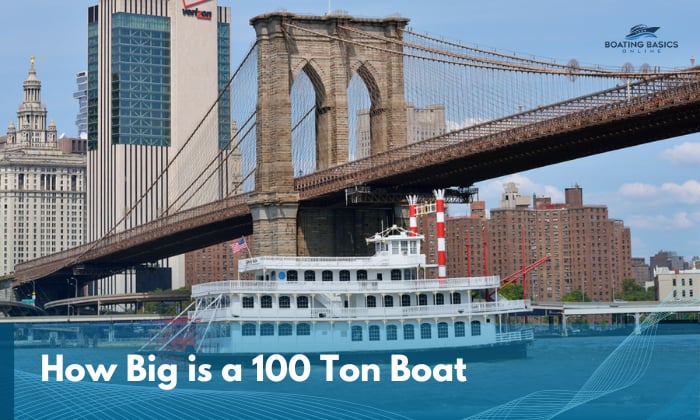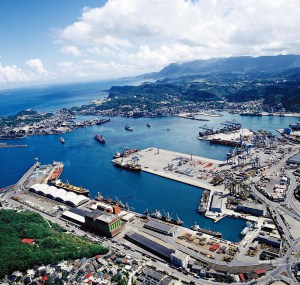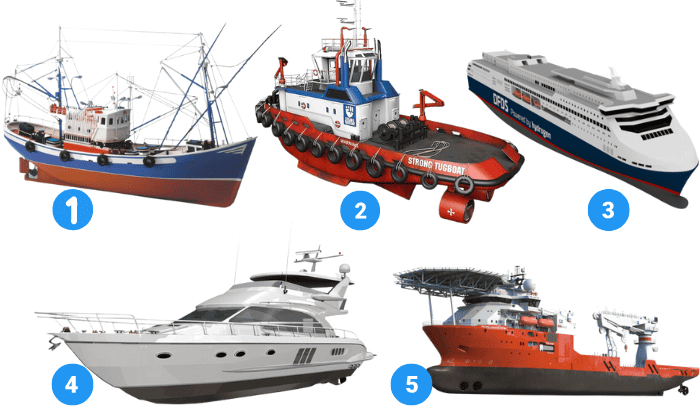There are a load of reasons why folks ask, “How big is a 100-ton boat?” Since it’s about size, I will answer this question based on tonnage, which measures a boat’s overall size based on volume.
The size of a 100-ton vessel varies a lot, but it’s generally accepted that 65 feet is the minimum. Such vessels also typically have two stories or more. Remember that internal volume isn’t the sole indicator of size. The length overall (LOA), beam, and draft are needed to get the full picture.
Table of Contents
Dimensions of a 100-ton Boat
One thing is clear when pinpointing the dimensions of a 100-ton ship: it’s fairly large.
But ultimately, every ship has a different LOA, beam, draft, etc., which is why we often have to manually measure each vessel to truly know its exact dimensions and, in turn, size.
Either that or you need to consult the actual boat designers and manufacturers about the exact dimensions of the boat. We can’t use gross tonnage solely to get the boat’s perfect measurements, as it only refers to the ship’s overall internal volume.
To further prove that gross tonnage isn’t directly proportional to vessel size, just observe the world’s biggest watercraft by gross tonnage:
- As you can see, smaller vessels also have high gross tonnage values. That may mean they’re designed to maximize their cargo-carrying capacity.
- On the other hand, there are also larger ships with relatively lower gross tonnage. That could indicate its designers put more emphasis on internal volume rather than carrying capacity.
1. Size in terms of length, width, and height
The USCG Master Licence does provide us with clues, though. Once you complete the 100-ton Master requirements, they explicitly state that you can now handle vessels of 65 feet and larger.
That is clearly the sole set parameter we can ever have in terms of tonnage with regard to size. It’s infinitely easier to calculate the gross tonnage using the boat’s dimensions which you have manually measured yourself or as indicated in the boat’s design plans.
After all, we can calculate gross tonnage by using the formula:
Gross Tonnage=L×W×H×Block Coefficient
Another formula we can follow is the more standard Gross Tonnage (GT) = K1V (with V being the volume of enclosed space on the ship and K being 0.2+0.02log10(V)), but it only applies to larger ships like cargo and passenger vessels.
And, even after we’ve calculated the exact gross tonnage, we can only ever estimate the size, which can still be larger or smaller, as proven by the link to the table shared above.
So, we’ll ultimately have to rely solely on the indicated length for a 100-ton vessel to get an idea of its size, especially if we don’t have a vessel to measure or the exact dimensions aren’t readily accessible. Moreover, length is arguably the most important parameter when classifying boats in the first place.
That said, if you insist on getting a rough estimate as to width and height, then know that a 100-ton boat can have beams 16 to 25 feet wide, whereas its height is at least 2 stories.
2. Capacity and features
To get the capacity of a 100-ton boat, we need to consider the fact that 1 net ton is equal to 100 cubic feet. Assuming a 100 gross ton boat also has a net ton of 100, its cargo volume would therefore be 10,000 cubic feet. Its average displacement should be around 224,000 pounds.
Its features will inevitably vary as it can be any kind of large boat.
A yacht of this capacity may have more amenities, a more sizable dining or lounging area, and more rooms.
A typical tugboat will have rotating azimuth units, and they generally have powerful engines, too.
On the one hand, yachts will have wider viewing decks, more seats, restrooms, and other possible amenities.
3. Factors that influence the size of a boat
- Intended purpose
A kayak may be designed to be shorter to make it more maneuverable and portable, while a passenger ship will inevitably be larger to safely accommodate as many people, crew, and amenities as possible. You typically require a bigger boat when doing offshore fishing than inshore, too.
On the topic of shipping, containerships often optimize their carrying capacity. Usually, their size, capacity, and categorization are determined by their TEU (Twenty-foot Equivalent Unit) capacity. It’s termed as such because 1 TEU is equivalent to one 20-foot container.
Ultra-large container vessels have more than 14,500 TEU, which means, yes, they can fit 14,500 boxes of that specific size.
- Estimated length of the trip
Lengthy journeys tend to require more amenities and sturdier construction to withstand unexpected rough conditions. This results in a larger boat size than vessels intended for short trips.
- Engine power
Vessels designed to reach a higher speed typically require bulkier engines, which in turn will call for a larger boat to accommodate them.
- Other considerations
Manufacturers take note of boaters’ different storage options, budgets, dock spaces, and trailering options when deciding the sizes of boats they create.
4. Comparison to other boat sizes
100-ton vessels are larger than most recreational boats, but may be smaller than your average commercial fishing vessel or cruise ship. The closest size would likely be that of a standard tugboat.
That already means a 100-ton boat is bigger than most dinghies, PWCs, kayaks, motorboats, and even sailboats.
Interestingly, it’s entirely possible to build a whopping 230-foot passenger vessel and keep it at or even below 100 gross tons with the right strategy (by, for example, knowing where to place fuel cells and utilizing tonnage openings).
So, yes, we shouldn’t fully consider it impossible for a 100-ton boat to rival even the world’s largest cruise ships and container ships in size. That should hammer the point that tonnage can only be connected to size up to a certain point.
Types of Boats That Can Be Classified as 100-ton Boats
When pinpointing the types of boats that you can classify as 100-ton vessels, you need to be able to distinguish the ones that relate to weight more from those that connote capacity.
For example, the 100 Yacht by Sunseeker has been referred to as a 100-ton yacht because it displaces that much water, and not necessarily because it has 100 gross tons. Again, “tonnage” is different from displacement tons! We need to be looking at gross tonnage (GT) if size is the main concern.
If we’re going by size estimations and typical applications and purposes alone, below are the types of boats that can be classified as 100-ton vessels. Again, note that the length, width, and depth are rough estimates and not definitive figures.
| Boat Type | Length (ft) | Width (ft) | Depth (ft) |
| 1. Fishing boats | 68. 2 | 21.6 | 7.5 |
| 2. Tug boats | 80 | 25 | 8 |
| 3. Passenger ferries | 80 | 25 | 10 |
| 4. Yachts | 1o0 | 25 | 10 |
| 5. Supply vessels | 100 | 35 | 15 |
Conclusion
The answer to “How big is a 100-ton boat?” will always be that it starts at 65 feet. From there, your design decisions will greatly affect the final shape and size of the vessel while still maintaining a gross tonnage of 100.
There’s a lot of confusion when it comes to this topic, I admit. This only underscores the importance of widening your maritime knowledge further while honing your seamanship at the same time.

“My intention from the first day establishing Boating Basics Online is to provide as much help as possible for boaters who want to experience a first safe and convenient trip. So feel free to join us and share your beautiful journeys to the sea!”







